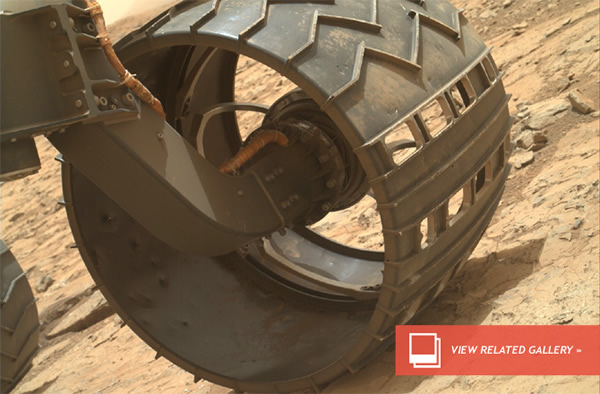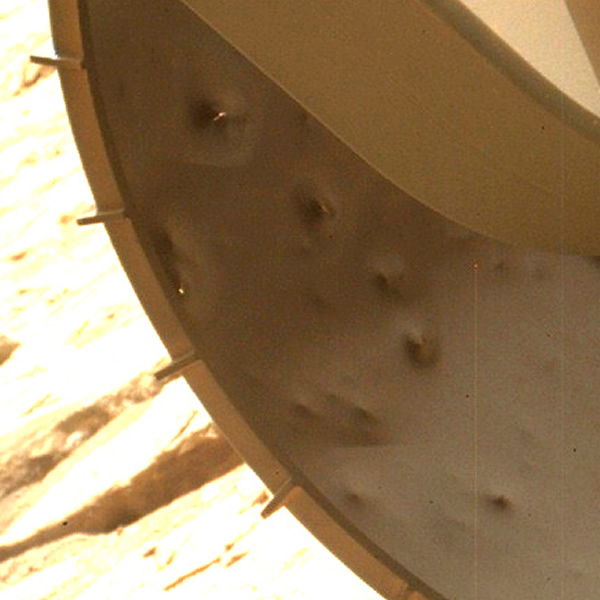Rough Roving: Curiosity's Wheels Show Damage
Curiosity’s dusty wheels. Dents are evident on the inner edge of the wheel’s skin and scratches cover the outer edge.
If, like me, you spend time obsessively perusing the thousands of incredible raw images flooding from NASA’s Mars rover Curiosity every day (or sol), you may have noticed that the car-sized robot is picking up obvious signs of wear and tear. Dust is an inevitable part of rolling in the Martian dirt, but Curiosity’s 20 inch (50 centimeter) wheels have picked up more than just dust, they have some pretty gnarly dents and scratches, too.
Having only traveled less than a kilometer from its landing site, 281 sols into its several-mile, two year primary mission (a mission that will be extended assuming full health of the rover is maintained), could these early signs of wheel damage be a problem for the longevity of Curiosity’s Mars roving?
Pushing this concern for Curiosity’s mobility to one side for now, I pondered the tough engineering tests these wheels would have been subjected to during rover construction. But surprises do happen, after all, especially when exploring a brand new region on an alien world. Could the material inside Gale Crater be harsher than predicted?
Take, for example, Curiosity’s rocket-powered landing on the Martian surface on Aug. 5, 2012. On viewing the stunning high-resolution photos from the robot’s MastCam, I noticed small rocks littered the deck of the rover. Indeed, during landing, mission managers suspected an errant piece of gravel was the likely culprit that damaged one of Curiosity’s wind sensors.
During one of the press conferences that followed, I asked the rover team about the rocks that littered the rover’s deck. Although they quickly ruled out any complications with the debris being there, they did admit that the debris was “unexpected.” The gravel could have been of a lower density than predicted, causing it to be kicked off the surface higher than expected, one of the first of many surprises that have excited the world in the first few sols of this historic mission.
So in the spirit of Martian surprises, could this rover wheel wear and tear be an unexpected side effect of rolling such a massive robot across jagged bedrock? Fortunately, there’s good news.
Detail of the inner edge of Curiosity’s front left wheel (contrast enhanced) — dents and possible punctures are evident.
“The wear in the wheels is expected,” Matt Heverly, lead rover driver for the MSL mission at NASA’s Jet Propulsion Laboratory (JPL) in Pasadena, Calif., told Discovery News via email. “The ‘skin’ of the wheel is only 0.75mm thick and we expect dents, dings, and even a few holes due to the wheels interacting with the rocks.”
Curiosity’s wheels are constructed from tough aircraft-grade aluminum, but they will certainly bear the brunt of rock attrition as the mission progresses.
Back on Earth, JPL scientists carry out test runs on Curiosity’s skinny “twin” rover. The “Scarecrow,” as its lovingly called, carries the same mass that Curiosity carries on Mars. Keep in mind that Mars gravity is roughly one-third of that on Earth, so the Scarecrow looks very spidery and small compared to its Martian sibling.
“We have the same wheels on our Scarecrow test rover, which weighs the same on Earth as Curiosity weighs on Mars,” Heverly added. “We have driven Scarecrow about 12 kilometers (7.5 miles) in the Marsyard over rocks and slopes much harsher than we expect for Curiosity.
“There are some dents and holes in these wheels, but the rover is still performing well.”
As seen in the inset image above, a closeup section of the inner edge of Curiosity’s front left wheel not only has obvious denting, there may also be the beginnings of punctures in the aluminum skin. It may seem alarming, but it is an expected consequence of roving on Mars.
“We will continue to characterize the wheels both on Mars and in the Marsyard, but we don’t expect the wear to impact our ability to get to Mt. Sharp,” said Heverly.
The top photograph was captured by Curiosity’s Mars Hand Lens Imager (MAHLI), a camera mounted on its robotic arm, on sol 275 of the mission to Gale Crater. Periodically, MSL rover drivers command the camera to survey the rover’s undercarriage and wheels to look for damage. The famous “self portraits” are used for the same reason — to make sure the rover is fully intact and to monitor dust build-up.
So, when looking closely at the wonderful array of imagery being beamed back from Mars, keep in mind that Curiosity’s big wheels were designed to dominate Mars, but don’t be surprised if they pick up some battle scars on the way.(May 22, 2013 03:23 PM ET // by Ian O'Neill)













